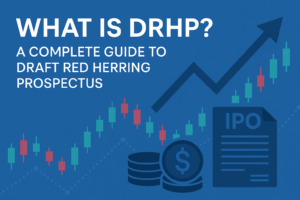IPO Allotment Process: How Shares Are Actually Allocated to Investors
📌 Table of Contents
- Introduction to IPO Allotment
- Investor Categories in an IPO
- Step-by-Step IPO Allotment Process
- Basis of Allotment: How It Differs by Category
- What If the IPO is Undersubscribed or Oversubscribed?
- Timeline of IPO Allotment
- Refunds, Share Credit & Listing
- Common Reasons for IPO Non-Allotment
- Strategies to Improve IPO Allotment Chances
- Final Thoughts

1. 🧐 Introduction to IPO Allotment
An Initial Public Offering (IPO) is a process through which a private company offers its shares to the public for the first time. For retail and institutional investors alike, IPOs are a gateway to investing early in promising companies. But applying does not guarantee share allotment. That’s where the IPO allotment process comes in — the method by which shares are distributed among applicants.
Understanding this process helps investors set realistic expectations and use smarter application strategies.
2. 👥 Investor Categories in an IPO
SEBI (Securities and Exchange Board of India) mandates the IPO to reserve shares for different categories of investors:
| Category | Full Form | Allotment Basis |
|---|---|---|
| RII | Retail Individual Investor | Lottery |
| NII/HNI | Non-Institutional Investor / High Net-worth Individual | Pro-rata |
| QIB | Qualified Institutional Buyer | Discretionary |
| Anchor Investors | Reserved QIBs (pre-IPO) | Discretionary |
Each category is allocated a fixed portion of the issue size:
- Retail Investors: 35%
- QIBs: 50%
- NII/HNIs: 15%
- Employees & Shareholders (if any): Separate reservation
3. 🔁 Step-by-Step IPO Allotment Process
Here’s a breakdown of how the IPO allotment process works in India:
Step 1: IPO Opens for Subscription
Investors place bids through ASBA (Applications Supported by Blocked Amount) via banks or brokers.
Step 2: Application Verification
The registrar (e.g., Link Intime, KFintech) verifies applications and filters duplicates or invalid PAN entries.
Step 3: Subscription Status Finalized
After the 3-day bidding period, the total number of bids received is analyzed per category.
Step 4: Basis of Allotment Finalized
Registrar works with the stock exchange to create a Basis of Allotment (BOA) based on subscription numbers.
Step 5: Share Allotment
Shares are allotted per the BOA. If oversubscribed, allotment happens via lottery (Retail) or pro-rata (HNI).
Step 6: Unblocking of Funds & Refund
Excess funds are released or refunded to investors whose bids were unsuccessful or partially filled.
Step 7: Shares Credited to Demat
Allocated shares are transferred electronically to the investors’ Demat accounts.
4. ⚖️ Basis of Allotment: How It Differs by Category
Let’s break it down further:
🔹 Retail Investors (RII)
- Apply for up to ₹2 lakhs.
- Allotment is done via lottery system.
- If IPO is oversubscribed, every unique PAN gets 1 lot maximum on a lottery basis.
- If undersubscribed, full allotment is likely.
🔹 Non-Institutional Investors (NII/HNI)
- Bids above ₹2 lakhs.
- Allotment is pro-rata based on the size of the application and oversubscription.
- Example: If HNI category is subscribed 10x and you applied for 10 lots, you may get 1 lot.
🔹 Qualified Institutional Buyers (QIB)
- Mutual funds, banks, insurance companies, etc.
- Shares are allotted discretionarily by the issuer in consultation with merchant bankers.
- No IPO allotment before anchor investor phase.
5. ⚠️ What If the IPO is Undersubscribed or Oversubscribed?
✅ Undersubscribed
If the total application is less than the shares offered:
- Investors receive full allotment.
- Remaining shares may be moved to other categories or canceled.
❌ Oversubscribed
- IPOs like Nykaa, Zomato, or LIC received massive oversubscription.
- In such cases:
- Retail: Allotment via computerized lottery.
- HNI: Pro-rata with very small allotment.
- QIB: Discretionary.
6. 📅 Timeline of IPO Allotment
| Day | Event |
|---|---|
| T (Opening Day) | IPO opens for bids |
| T+3 | IPO closes |
| T+4 | Final subscription data published |
| T+6 | Basis of Allotment finalized |
| T+6 | Refund initiation / fund unblocking |
| T+7 | Shares credited to Demat |
| T+8 | Listing on stock exchange (NSE/BSE) |
Note: T refers to IPO opening date. These are business days.
7. 💸 Refunds, Share Credit & Listing
If shares are not allotted:
- The blocked amount is unfrozen in your bank account.
- In case of partial allotment, the remaining amount is refunded.
Shares allotted will be visible in your Demat account via NSDL/CDSL. You can sell these on the listing date after market opens.
8. 🚫 Common Reasons for IPO Non-Allotment
- PAN mismatch or incorrect details
- Duplicate applications with the same PAN
- Low funds or insufficient balance
- Technical rejections by the bank or registrar
- High oversubscription (luck factor)
9. 📈 Strategies to Improve IPO Allotment Chances
While no method guarantees allotment, you can improve your odds:
✅ Apply via Multiple PANs
Ask family members with separate Demat + PAN to apply individually.
✅ Always Apply at Cut-Off Price
Retail investors should always tick the “Cut-off” box.
✅ Submit Application Early
Banks and brokers may have internal cut-off times. Apply on Day 1 or 2.
✅ Use Multiple Demat Accounts
If multiple Demat accounts exist under different PANs, apply through each.
✅ Ensure Sufficient Bank Balance
Maintain funds until the allotment date to avoid rejection.
10. 🔚 Final Thoughts
The IPO allotment process is systematic, transparent, and regulated. While luck plays a role in oversubscribed IPOs, understanding how allotment works can help you apply strategically and manage expectations. Whether you’re a retail investor looking for listing gains or a long-term player, knowing the mechanics of allotment empowers smarter investing.
✅ Key Takeaways
- IPO allotment is based on category-specific rules.
- Retail investors get a lottery-based 1 lot if oversubscribed.
- HNIs receive pro-rata allotment based on application size.
- Refunds and share credit follow a strict timeline.
- Applying smartly can improve your chances.
Share this content:






Post Comment